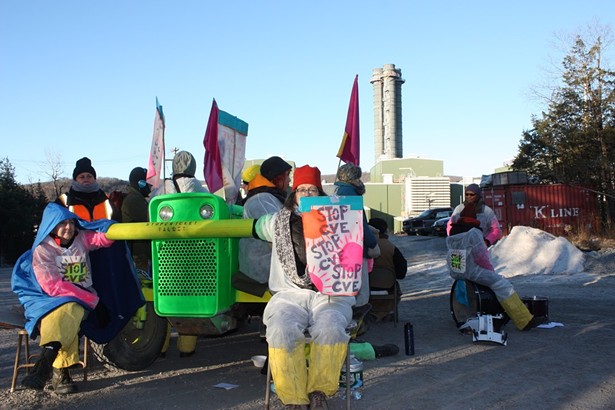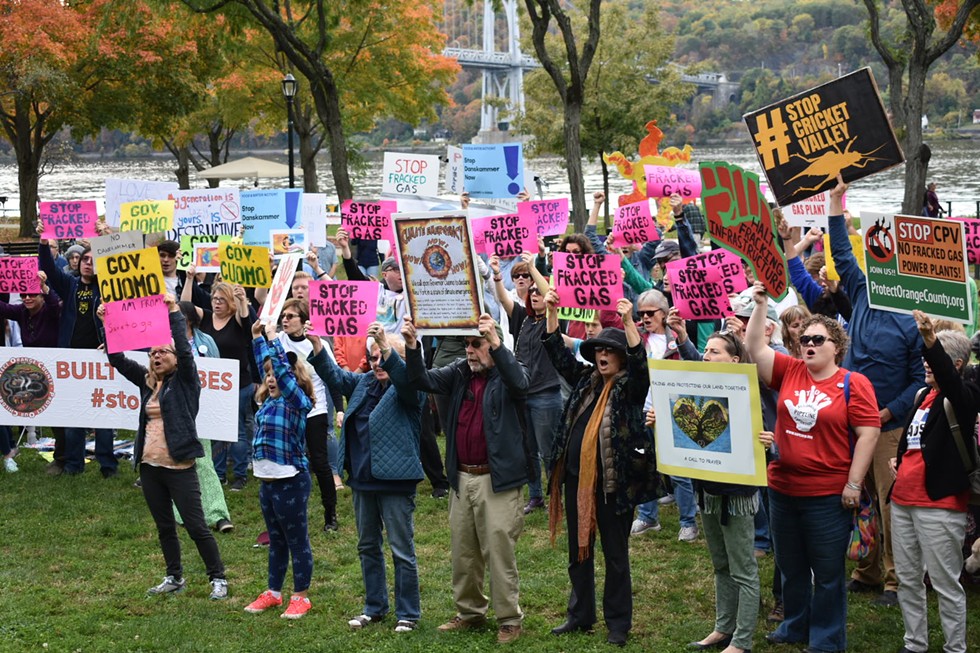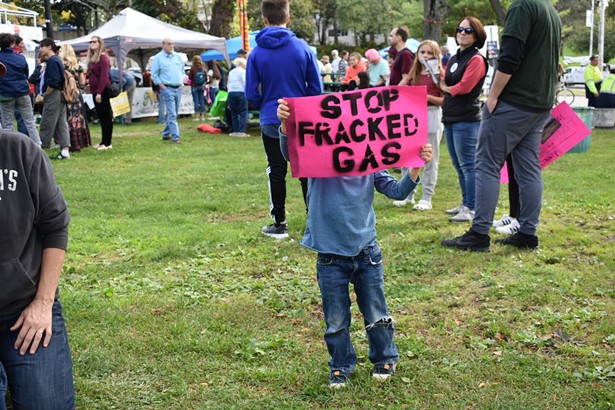On October 13, the banks of the Hudson were painted with fall foliage and dotted with the brightly colored signs of the 250 people who had gathered at Waryas Park in Poughkeepsie to yell at Governor Andrew Cuomo. Literally. What did they want? Climate action! (Or so went a chant that broke out among the crowd.) And when did they want it? Now!
Although Cuomo declined an invitation to attend, the “Earth to Cuomo” rally was organized to get his attention. The purpose was to protest New York's increasing reliance on fracked natural gas as an energy source. Although the governor signed a bill banning in-state fracking in 2014, New York is still entwined in networks of fracking infrastructure elsewhere because of newly built power plants that burn fracked gas that has been piped in from out of state.
In the past, Cuomo has advocated for transitioning the state away from carbon-based energy sources. He established the Clean Energy Standard in 2016, and this summer he signed the Climate Leadership and Community Protection Act, which targets a 40-percent reduction in carbon emissions by 2030 and a net-zero energy policy by 2050. But now, according to protesters, Cuomo’s professed environmentalism is being put to the test. The impending closure of Indian Point, the nuclear power facility just south of Peekskill, means that New York needs new sources of energy. To bridge the gap with renewables like hydropower and solar would require additional investment in these sources, which currently account for 23 percent of New York’s energy. Instead, the shortage has so far been addressed by building new natural-gas-burning power plants. One such plant is the Cricket Valley Energy Center (CVE), a 1,100-megawatt facility in Dover, which is set to begin operating in 2020. To some New Yorkers, Cuomo’s lack of resistance to this plant makes it seem like he’s not walking the walk.
According to Cricket Valley’s website, the plant will create local jobs for up to 28 full-time employees and generate an annual tax revenue of at least $3 million. The website also claims that the facility will be environmentally responsible. But from the time of the plant's proposal in 2011, protesters have insisted otherwise. Resistance efforts have come from groups like New York Public Interest Research Group, Mothers Out Front, Dutchess County Progressive Action Alliance, Schaghticoke First Nations, and STOP Cricket Valley, with calls for investments in solar and wind power instead. These efforts escalated in January, when four local men blocked the delivery of a turbine to Cricket Valley by chaining themselves to a tractor on the road.
Construction of the $1.5 billion plant was funded by several private overseas equity investors, but it will be owned and operated by Advanced Power, a private energy infrastructure company based in Switzerland. The plant will burn fracked natural gas transported through the Iroquois Pipeline, which runs down from Canada through New York. The pipeline was first proposed in 1985 and began operations seven years later. During this time, there was widespread resistance to the pipeline due to the environmental impacts of building it, as well as the pollution caused by the natural gas it was to transport.
Burning natural gas has been promoted by the oil and gas industry as a cleaner alternative to coal and a bridge-fuel source to 100-percent sustainability. However, even though it emits less carbon dioxide than coal, burning natural gas still creates significant pollution. Cricket Valley’s own documents predict that the plant will produce 279 tons of nitrogen oxide (NOx) each year. According to a 2018 summary of studies by the Union of Concerned Scientists:
Not only does NOx cause respiratory problems, but NOx also reacts with other substances in the air to produce particulate matter and ozone. Particulate matter and ozone cause the extensive list of adverse health outcomes you hear at the end of a prescription drug commercial—shortness of breath, heart attacks, premature death; the list goes on. In short, NOx is bad news for human health.
Cricket Valley does have technology in place to limit emissions as much as possible. For nitrogen oxides, the plant will use Selective Catalytic Reduction (SCR), an emissions control technique which uses Diesel Exhaust Fluid to separate NOx into its less-threatening components.
To predict the effects of NOx and other potential emissions from Cricket Valley, it's worth visiting Wawayanda, in Orange County, where a smaller, 680-megawatt plant is operated by Competitive Power Ventures (CPV). The plant went online in late 2018; not long afterward, local residents began complaining of adverse health effects. Surveys done by Protect Orange County and State Senator Jen Metzger (D-Rosendale) found increased rates of headaches and respiratory illness.
In addition, the New York Department of Environmental Conservation denied the plant its Title V Air Permit in 2018, maintaining that a new, more thorough permit from the EPA was required. CPV successfully sued for an injunction that would allow the plant to continue operating, but it still has not secured a new permit.
Several of the 21 speakers at the rally presented CPV's plant as a dire warning on the potential dangers of Cricket Valley.
Legally, Cricket Valley has obtained all the necessary permits, with the help of something called emissions offsets. These are allowances for additional emissions based on predicted reductions from existing emissions sources. Emissions offsets will allow the plant to produce an additional 115 percent of its maximum permitted annual emissions. Securing these offsets was necessary for two reasons. First, Cricket Valley is classified by the EPA and the NYDEC as a new major source of pollution, and a source of nitrogen oxides (NOx). Secondly, Dutchess County is part of a region that does not meet National Ambient Air Quality Standards for ozone, and thus is classified as an “ozone non-attainment area.” Because nitrogen oxides will contribute to the formation of ozone, it had to be proven that Cricket Valley’s surplus of NOx emissions will be cancelled out by reductions from older sources in the region. CVE's Final Environmental Impact Statement states that “by obtaining direct NOx emissions offsets in quantities exceeding the Project’s maximum permitted emissions and further displacing the operation of existing less efficient and higher emitting units, the Project will result in a significant net reduction in regional NOx emissions.” But while the plant may cause a reduction in regional emissions, pollutants will be concentrated in the Hudson Valley, less than a mile from the Dover Elementary School.
Many concerned citizens, including local attorneys Michael Sussman and Joshua Douglass, have requested additional studies. The two went to court in early October seeking a temporary restraining order to postpone operation of the plant until a supplemental environmental impact study has been done, and the court case is ongoing. Sussman and Douglass maintain that the plant's approval was based on obsolete science.
“The DEC has a responsibility to protect the planet and our health…the DEC is not doing its job,” Douglass said at the Earth to Cuomo rally. Sussman expressed his own frustration when he addressed the crowd: “We have no more time for political compromise. Only anger, strong demands, and persistence will get it done.”
But will anger from the rally-goers be enough? Two-hundred and fifty people at a rally is unlikely to get the governor's attention, especially when organizers were hoping for a turnout of 1,000. For this reason, those present were encouraged to take to social media and use hashtags like #earthtocuomo to amplify their voices.
As of mid-December, it’s clear the rally did not elicit a response from Governor Cuomo. But efforts continue: On November 16, protesters shut down construction for the day by blockading the entrance to the facility, and 29 arrests were made. On December 19, Douglass and Sussman furthered their arguments for an injunction at the New York State Supreme Court in Poughkeepsie. But as the new year approaches, time is of the essence. The plant is scheduled to start operations in January, and protesters know that once up and running, it will be a lot harder to shut down. Power plants are built to operate for decades and, according to a report by Oil Change International this May, investing in these facilities ties us to long-term reliance on fracked gas:
Multibillion-dollar gas infrastructure built today is designed to operate for decades to come. Given the barriers to closing down infrastructure ahead of its expected economic lifespan, it is critical to stop building new infrastructure, the full lifetime emissions of which will not fit within Paris-aligned carbon budgets.

Plants like CPV and Cricket Valley are at odds with the goals of the Climate Leadership and Community Protection Act, which Cuomo signed just months ago. But these seeming contradictions have protesters hopeful that Cuomo’s mind can be changed. To them, it is not just about one power plant—it's about the direction they want to see the Empire State taking. Will New York be at the forefront of sustainable energy? Or will we preach sustainability while strengthening our reliance on fossil fuels behind the scenes?
One hopeful is Charles Davenport, a resident of Wappingers Falls who's been protesting outside the plant every week since 2011. When asked what keeps him going, Davenport cited similar protests that have made a difference in recent years. After all, Cuomo's decision to ban fracking in 2014 was spurred by thousands of people protesting and calling his office. And in 2016, the grassroots campaign We Are Seneca Lake successfully prevented the region around the upstate lake from being used for methane storage by a Texas-based energy company, a triumph won with diligent protesting that included more than 650 arrests.
These past victories brought a sly smile to Davenport's face. “If you have enough people in the streets,” he said, “anything is possible.”



















